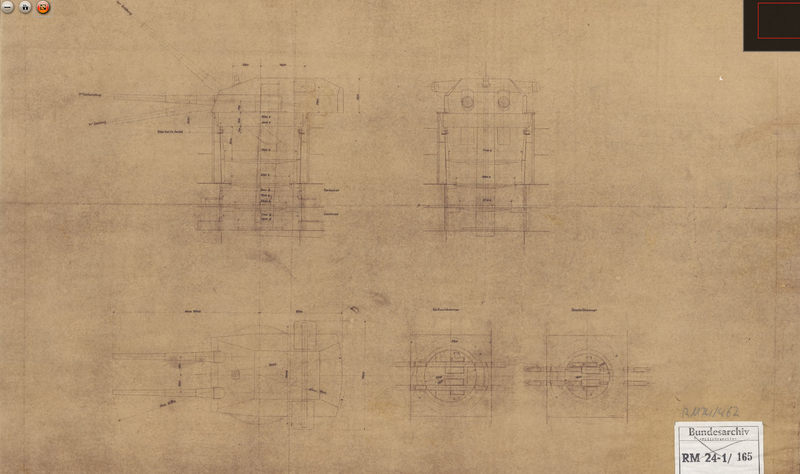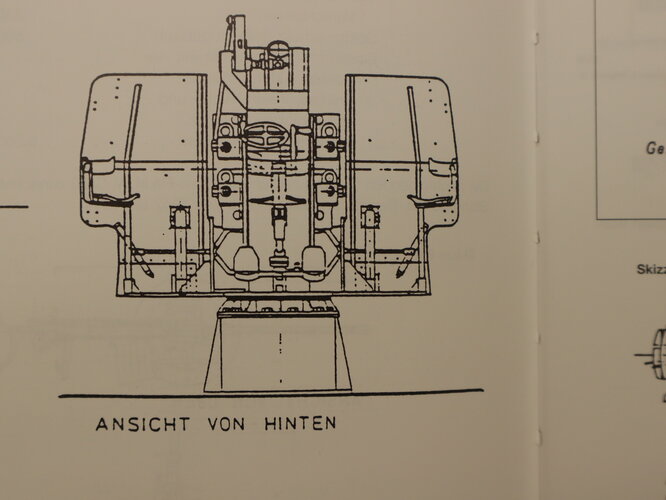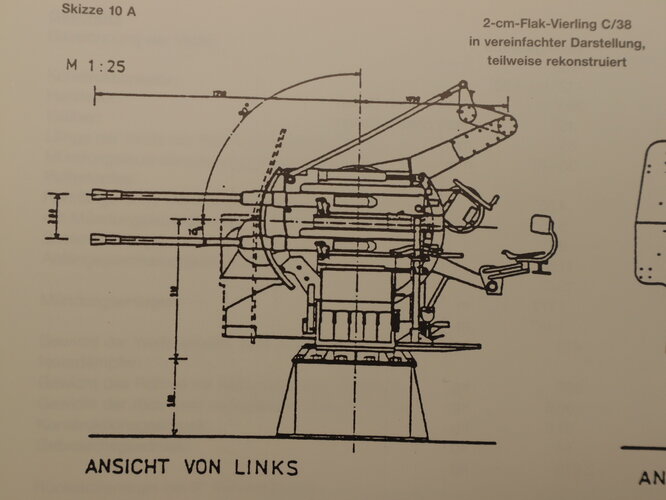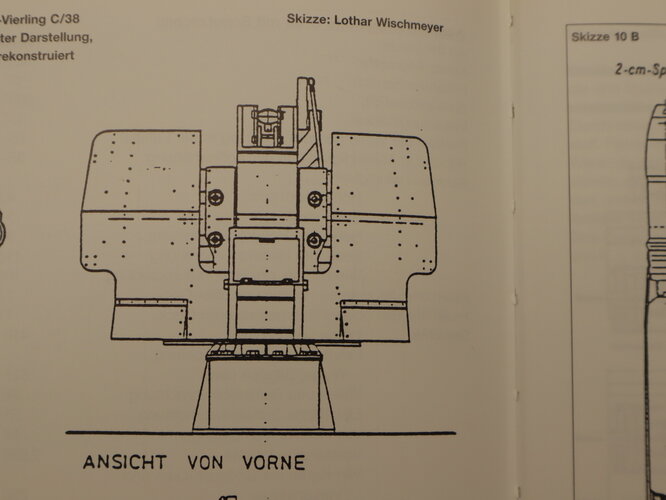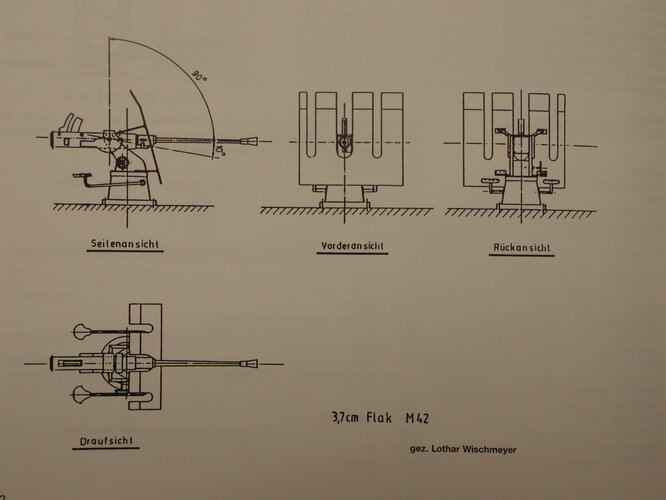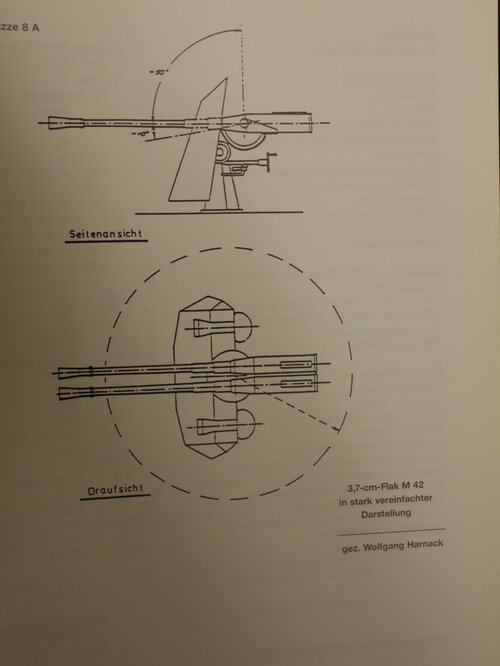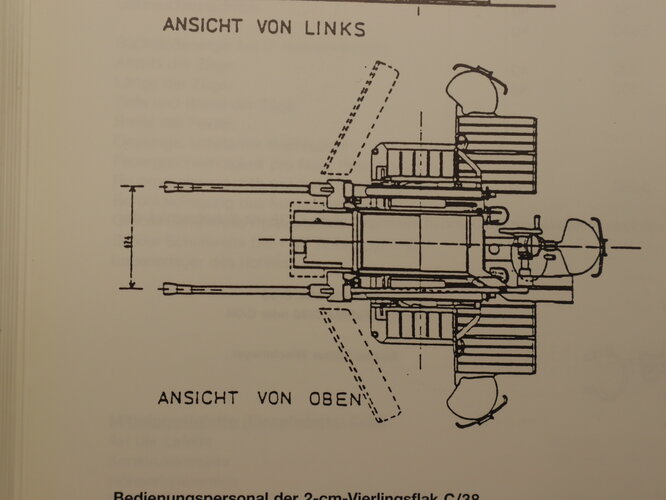You are using an out of date browser. It may not display this or other websites correctly.
You should upgrade or use an alternative browser.
You should upgrade or use an alternative browser.
Kriegsmarine - KM Naval Armament Plans/Discussion
- Thread starter _Sarcasticat_
- Start date
_Sarcasticat_
Die Katze.
- Joined
- 16 April 2020
- Messages
- 364
- Reaction score
- 351
Some. I can provide for the 3cm Flak 103/38. (Technical data and the like) and some small low-resolution photos. Unfortunately all the great data books for the MK 103 from deutscheluftwaffe.de have not been uploaded from the old site as of right now and I do not have them. I wish I could find someone who has them, they are an unbelievably excellent resource.Do you have any blueprints of smaller aa guns like FLAK 103/38 and some else?
I've saw 40.6 cm/52's reloading speed only about 30 seconds while 38 cm/52 SK C/34 can reload in 20 seconds technically. Is it record for 40.6 cm/ 52coastal version(what really made) so naval version(which is only designed) is faster or just naval version has slower reload rate than 38 cm?
_Sarcasticat_
Die Katze.
- Joined
- 16 April 2020
- Messages
- 364
- Reaction score
- 351
It may be that the 40.6cm's noted reload time is 30s because that is the average while you are comparing the 38cm's fastest time. However, if the weight of the projectile and powder + case are taken into account in regard to the ammunition elevation motor and rammer, the 40.6cm SHOULD be capable of reloading at that speed.I've saw 40.6 cm/52's reloading speed only about 30 seconds while 38 cm/52 SK C/34 can reload in 20 seconds technically. Is it record for 40.6 cm/ 52coastal version(what really made) so naval version(which is only designed) is faster or just naval version has slower reload rate than 38 cm?
However, technology is often limited by the times, meaning that you may see a reduction in reload speed as one might expect.
_Sarcasticat_
Die Katze.
- Joined
- 16 April 2020
- Messages
- 364
- Reaction score
- 351
Yes, they did. It improved accuracy considerably even if rangefinding was still done optically (it wasn't until about 1944 for Germany that they fitted the Wurzburg-D anti-air radar to an SL director).Did the various tri-axial mounts/turrets have any significant advantage over the more standard mounts?
Colonial-Marine
UAVs are now friend, drones are the real enemy.
- Joined
- 5 October 2009
- Messages
- 1,477
- Reaction score
- 1,336
I'd have to guess that being limited to 52 or 62 degrees of elevation is going to be a pretty severe limit on the utility of heavy AAA. Once dive bombers get past the outer flak radius they could take all day above the target forming up for an ideal attack. Same with heavy level bombers.
Even if the war was going a lot better for Germany I'd imagine that realistically they would have waited for that final turret design using either the 128mm/61 caliber Flak 40 or a shortened 54 caliber version of it.
Going off the tables on Navweaps it seems like the shells used by the 128mm/45 caliber SK C/34 and SK C/41 have a slightly greater range at 45 degrees than the shells of the Flak 40 despite the significantly higher muzzle velocity of the Flak gun. I wonder if that is an error.
Even if the war was going a lot better for Germany I'd imagine that realistically they would have waited for that final turret design using either the 128mm/61 caliber Flak 40 or a shortened 54 caliber version of it.
Going off the tables on Navweaps it seems like the shells used by the 128mm/45 caliber SK C/34 and SK C/41 have a slightly greater range at 45 degrees than the shells of the Flak 40 despite the significantly higher muzzle velocity of the Flak gun. I wonder if that is an error.
_Sarcasticat_
Die Katze.
- Joined
- 16 April 2020
- Messages
- 364
- Reaction score
- 351
The turrets traverse and elevate too slow to be useful at close ranges - and that applies (or is likely to apply) for all of them, sans potentially the LM44. The only ships that would not be capable of being engaged are dive bombers/level bombers at closer ranges, but those are typically engaged by 2cm and 3.7cm Flak at that point, which are far more effective weapons for close-in engagement and exactly why they exist. 62 degrees is adequate to engage aircraft in the outer and medium-distance zones. 62 is actually higher than most think.I'd have to guess that being limited to 52 or 62 degrees of elevation is going to be a pretty severe limit on the utility of heavy AAA. Once dive bombers get past the outer flak radius they could take all day above the target forming up for an ideal attack. Same with heavy level bombers.
Even if the war was going a lot better for Germany I'd imagine that realistically they would have waited for that final turret design using either the 128mm/61 caliber Flak 40 or a shortened 54 caliber version of it.
Going off the tables on Navweaps it seems like the shells used by the 128mm/45 caliber SK C/34 and SK C/41 have a slightly greater range at 45 degrees than the shells of the Flak 40 despite the significantly higher muzzle velocity of the Flak gun. I wonder if that is an error.

Just because the elevation is not 75 degrees+ does not mean that the elevation is insufficient in the role it was intended for, especially given the date of design, size of the turret, and the weapons intended to be housed in them
Maximum surface range does not matter as much as maximum vertical performance or, much more importantly, effective range, with the latter being determined by and large by muzzle velocity. Even in naval battles, given the close ranges destroyers typically fight at, the higher muzzle velocity would be welcome. No destroyer is going to be firing at maximum range (with anything resembling effectiveness) as their small little 3-to-4 meter rangefinders cannot support it. Even the case the Flak 40 is used as a secondary weapon, its other role as anti-surface would see it firing at incoming destroyers at light cruisers which will attempt to close the range rapidly for torpedo runs.
It is not an error. You can determine this by studying the projectile weight. For the naval guns, it is 28 kg. For the Flak 40, it is 26.0 kg. This means that the lighter round will bleed off energy more at longer range and in trade it obtains greater muzzle velocity, which is key to accurate anti-aircraft fire because the chances are that you will not always be using maximum range because aircraft, bombers in particular, are not very accurate at those heights during this period.
Note: a similar (but not exactly so) principle is in use for Minengeschoss found on 2cm+ weapons.
And, of course, if you want to dive without breaking off your wings in the break-off or survive long enough to drop your bombs, you won't be diving from 12+km.
My final conclusion about the Flak 40 in C/38 is that is more than sufficient to be utilized in place of the "LM41" or LM44 and is more effective than the destroyer-tailored SK C/41 in Drhl. C/41.
If, and I am not saying you are, but if you are wondering why the KM uses 28kg if they are 'so much more ineffective', re-read the section regarding the developmental history of the SK C/41, in particular the section regarding projectiles.
Colonial-Marine
UAVs are now friend, drones are the real enemy.
- Joined
- 5 October 2009
- Messages
- 1,477
- Reaction score
- 1,336
Accurate assessment I think, although that lack of very high angle elevation for those guns would be a problem if you're stuck in the situation most German capital ships were stuck in later during the war. Bombers trying to drop a Tallboy on your stationary battleship are going to have an easier time without flak interference during the final run in to target. Of course I'm sure all of these potential refits would have necessitated a much improved wartime situation for the Kriegsmarine and Germany.The turrets traverse and elevate too slow to be useful at close ranges - and that applies (or is likely to apply) for all of them, sans potentially the LM44. The only ships that would not be capable of being engaged are dive bombers/level bombers at closer ranges, but those are typically engaged by 2cm and 3.7cm Flak at that point, which are far more effective weapons for close-in engagement and exactly why they exist. 62 degrees is adequate to engage aircraft in the outer and medium-distance zones. 62 is actually higher than most think.

Just because the elevation is not 75 degrees+ does not mean that the elevation is insufficient in the role it was intended for, especially given the date of design, size of the turret, and the weapons intended to be housed in them
Maximum surface range does not matter as much as maximum vertical performance or, much more importantly, effective range, with the latter being determined by and large by muzzle velocity. Even in naval battles, given the close ranges destroyers typically fight at, the higher muzzle velocity would be welcome. No destroyer is going to be firing at maximum range (with anything resembling effectiveness) as their small little 3-to-4 meter rangefinders cannot support it. Even the case the Flak 40 is used as a secondary weapon, its other role as anti-surface would see it firing at incoming destroyers at light cruisers which will attempt to close the range rapidly for torpedo runs.
It is not an error. You can determine this by studying the projectile weight. For the naval guns, it is 28 kg. For the Flak 40, it is 26.0 kg. This means that the lighter round will bleed off energy more at longer range and in trade it obtains greater muzzle velocity, which is key to accurate anti-aircraft fire because the chances are that you will not always be using maximum range because aircraft, bombers in particular, are not very accurate at those heights during this period.
Note: a similar (but not exactly so) principle is in use for Minengeschoss found on 2cm+ weapons.
And, of course, if you want to dive without breaking off your wings in the break-off or survive long enough to drop your bombs, you won't be diving from 12+km.
My final conclusion about the Flak 40 in C/38 is that is more than sufficient to be utilized in place of the "LM41" or LM44 and is more effective than the destroyer-tailored SK C/41 in Drhl. C/41.
If, and I am not saying you are, but if you are wondering why the KM uses 28kg if they are 'so much more ineffective', re-read the section regarding the developmental history of the SK C/41, in particular the section regarding projectiles.
Ultimately I just wonder if without that very high angle capability does it becomes better to stick with the 105mm SK C/33 in an improved enclosed mounting like that planned for the H-series battleships?
As for the maximum range of the 128mm guns I'm just surprised that 2kg of projectile weight can make up for 50-70 mps of velocity for a gun of this caliber. Guess I was underestimating how important shell weight is. Either would be adequate for surface action against destroyers I'm sure.
_Sarcasticat_
Die Katze.
- Joined
- 16 April 2020
- Messages
- 364
- Reaction score
- 351
For the time this gun was developed and for a short time in service it was quite decent. While much better than French 37mm guns from the period, it isn't quite as "conventionally" good as the 2-pounder Pom Pom gun developed for the RN and much less so than the very impressive and standard-setting 37mm/54 Breda Model 1932 of the RM.Were there any modifications for Graf Zeppelin in terms of AA guns? From what I heard those 37mm SK C30 were pretty bad.
That isn't to say that the 37mm/83 SK C/30 is bad, but operates on a philosophy that has not stood the test of time. Though for the time it was introduced the gun is what could be considered a strong contender for the apex of its design philosophy: shot quality over quantity.
The 3.7cm/83 SK C/30 features a triaxially stabilized mount with very long barrels, light rounds, and extremely high muzzle velocity. The horizontal and vertical ranges are very good (better than contemporaries), and each mount is directed by a 1.25 meter rangefinder. In short, one could say that SK C/30 is designed as a smaller, 37mm version of the larger triaxially stabilized weapons (8.8cm, 10.5cm, etc) and mimics them in principle, design, and operation to a reasonable degree.
What you have are a pair of very powerful cannons attached to a triaxial mount and dedicated rangefinder - the goal being to provide the most accurate and damaging fire from long ranges, a philosophy shared with the larger anti-aircraft artillery cannons. Germany was under the impression that the most effective AA screen would be set at long ranges, and planned accordingly. While it is not wrong to have that idea to avoid just getting dropped on by torpedo and dive bombers when you would otherwise just open fire, the ability to shoot both your 3.7cm and 2cm weapons at much higher rates of fire and at much closer ranges than the SK C/30 was capable of is certainly superior both in terms of physical and psychological effectiveness while only having to sacrificing accurate long-range fire.
German AA doctrine seems to have been:
Main Battery Barrage Fire --> 10.5cm/8.8cm --> 3.7cm --> 2cm
(exact path differing depending on weapons present)
Nowadays we know that the best thing to do is just brrrt as many rounds as humanly possible at the target at much closer ranges, but that was not the case the last time they had developed naval AA weaponry. Having been prohibited from developing AA weapons with the Treaty of Versailles, Germany found it had a lot of catching up to do and appears to have decided to study what its neighbor, France, was doing and copy their homework. At this point (20's - early 30's) it does not seem clear to everyone that - in terms of 3.7cm/4cm guns - the superiority lie with rate of fire, though this would change later. Instead, Germany developed a gun that was accurate to very long ranges and as such sacrificed rate of fire and was fitted only with manual traverse and elevation, relying on 2cm automatic AA to do its due diligence at very close ranges.
As a whole, outside rate of fire, the stats for the 3.7cm/83 could be considered good. While the burst charge was average, the muzzle velocity is very high, and, as discussed in a prior post, high muzzle velocity is good for AAA work. The triaxial stabilization and 1.25-meter rangefinders helped to extend the effective range and accuracy of engagement for the weapons as well. Unfortunately the rate of fire in particular simply kneecapped this weapon in comparison with more modern types emerging and forced it into (by conventional standards) obscurity almost as soon as it was released in 1934. Honestly, to be put into service in the same year as the 37mm/54 Breda must be quite disheartening.
In service the weapon proved to be reliable enough and certainly accomplished what had been laid out for it to do. While most would wojak-point to Bismarck's battle against the Swordfish, it's becoming more and more common knowledge that it was likely the construction of the aircraft that limited the effectiveness of all guns (foresight, rightfully so, did not exactly account for this type of aircraft construction - especially when aircraft technology was moving at such a rapid pace) involved rather than the weapons simply being ineffective by nature. In fact, it was the opposite; the fire was described as highly (frighteningly) accurate, even if no planes were downed in that engagement.
It was not until war broke out that German long-range AA theory could actually be battle-tested, and things did not pan out as hoped. If that is the case, then why not just simply replace the 3.7cm/83 with Heer and Luftwaffe guns? Unfortunately for the Kriegsmarine, they had little choice. We know from prior discussion that the Luftwaffe and Heer both are much higher priority branches - the Heer being the traditional strong-arm of Germany and the Luftwaffe featuring the slimy, persuasive snake that is Hermann Goring (the KM dead last as the branch that had proved useless in the last war and mutinied in 1918) - and as such found the ability to get their hands on the more modern examples being developed for the other branches to be very difficult, especially after December 1942 when the KM had learned of their folly with the 3.7cm/83 and needed a replacement in production for their surface warships...only for said warships to end up largely deactivated.
You can see struggle faced by the Kriegsmarine by the fact that, much like the 128mm SK C/41, the Kriegsmarine had to steal and modify the design of a weapon (the Flak 36), tailor it to themselves, and then begin production/service (as the 3.7cm/69 M42) in 1943...only for it to be too late and priority go to arming the U-Boats with them.
The reason for such a struggle was because inter-service cooperation was atrocious. Not worse than the Japanese Army-Navy relations, but the branches certainly found it difficult to coordinate and hoarded whatever they could (example: over-filling ships' complements of sailors by ridiculous amounts) until 1944 when they were forced to share or else lose completely. Though by 1944 it was much too late and the only AA weapon aside from the 2cm/65 to see a strong common service between all three branches - the 3.7cm/57 Flak 43 - only made it to a few ships.
Perhaps if the autoloading system and Minengeschoss rounds been provided earlier than they were, the weapons might have been considered at least decent enough to avoid the common criticisms of today. But they were not, and the 3.7cm/83 SK C/30 goes down in history as an outdated weapon placed pointlessly on German designs during the war (the reality of which, as just discussed and as is typically the case, much more complicated).
To directly answer your question about GZ: no. Even in 1942 there were no planned AA changes because there was nothing to replace the SK C/30 with in the first place. Not yet, anyway.
In summary: the SK C/30 is a very decent weapon for what it was intended for, even in the opening years of WWII, but poor by conventional standards, completely outdated past ~1940/41, and did not quite live up to the hype when battle-tested. There was no choice in its utilization, though. Work on including the 3.7cm Flak 36 much earlier than 1942 (3.7cm SK C/36 and improved version 3.7cm Flak M42) might have seen a better-armed KM against the threat of aircraft than the misguided notions of 1930's long-range AA defense from a 3.7cm, but that's for an alternate universe to enjoy.
Remember that hindsight is 20/20, and direct 1v1 comparisons of naval guns can be about as meaningless as 1v1 battleship scenarios.
Last edited:
_Sarcasticat_
Die Katze.
- Joined
- 16 April 2020
- Messages
- 364
- Reaction score
- 351
I can imagine why. It's past 1945, there are jets now, and he's stuck with a 37mm single-shot AA gun from 1934. He probably didn't have the twin triaxial version, but the hand-cranked single is past useless in the postwar era.Thank you for info. My great grandfather was in AA battery in postwar Czechoslovakia and he said to me that he hated the SK C/30 gun really much.
lukasgrul
ACCESS: Confidential
- Joined
- 15 May 2021
- Messages
- 131
- Reaction score
- 113
Czechoslovakian version of MK 303 (Br) is called PLDvK vz. 53 Ještěrka (lizard). Here is a link to czech forum https://www.valka.cz/CZK-vz-53-30-mm-PLDvK-t1111.I know of this weapon, but I wish I knew how similar they were or if there was any differences. If there aren't many, if any at all, it could help to better understand the MK 303 (Br).Yes , he didn´t have the twin triaxial. But later he was using czech version of MK 303.
I do not believe so. There were some minor differences which were also reflected in B. The biggest being that a part of the propulsion was diesel so as to extend the range.Are there any blueprints of Flugzeugtrager C or D? I read somewhere that they would be a bit different than Graf Zeppelin.
_Sarcasticat_
Die Katze.
- Joined
- 16 April 2020
- Messages
- 364
- Reaction score
- 351
Do you have blueprint of 38cm SK C-34 L52 gun, and also a double turret for it?
38cm/52 SK C/34 - Google Drive
 drive.google.com
drive.google.com
_Sarcasticat_
Die Katze.
- Joined
- 16 April 2020
- Messages
- 364
- Reaction score
- 351
No, but given the date of design (1931) and the design it is basing off of (15cm/60 C/28) it could be pretty high. Possibly upwards of 6 RPM.Do we have any weight and / or rate of fire data for the new turrets recovered from the archives? the 20,3cm triple for example?
_Sarcasticat_
Die Katze.
- Joined
- 16 April 2020
- Messages
- 364
- Reaction score
- 351
Look under KM weaponry for 5.5cm.Do you have blueprints of 105 mm SK C/33 L65 in 1938 turret thar were on most Plan-Z ships? Are there any turrets for 55 mm Gerat 58?
I do not have the C/38 turret drawings though.
_Sarcasticat_
Die Katze.
- Joined
- 16 April 2020
- Messages
- 364
- Reaction score
- 351
That's an excellent question. I have no 100% for-sure answer, but my best guess is due to supply and supply line issues as well as her relative danger at the time she was in Norway compared to other units in the North and Baltic. U-Boats had undeniably surpassed the surface fleet by a very wide margin in priority and would always be the ones to receive the 3.7cm/69 guns first, leaving the surface units remaining after Hitler's rage in 1943 to scrape together whatever they could get their hands on despite the ambitious Barbara Programme. It is true that many ships were planned to receive the 3.7cm M42, even including Emden, but were curtailed by either the situation or by the lack of mounts to supply. For Tirpitz, she has the added issue of it being particularly difficult to ship those weapons far north enough to have her actually get them. By sea is essentially a death trap and over land does not appear any more viable. Besides, given her location, ships like Hipper, Eugen, Lutzow, Emden, and others needed the weapons far more as they were under much greater threat of aerial attack in the first place. If they're scraping by as far as procurement, then what does that leave Tirpitz?Do you know why Tirpitz didn´t get 40 mm FLAK 28 or 37 mm FLAK M/42 as replacement for 37 mm SK C/30 guns when ships like Prinz Eugen, Admiral Hipper and Lutzow did?
All is not so bad, even with the 3.7cm C/30. Recently I had a lively debate in a certain Discord server regarding the C/30's capabilities in relation to the 25mm Type 96. While both are undeniably obsolete by 1944 it did bring to light a lot of the hidden benefits that the 3.7cm possessed and certainly served to, at least as far as I am concerned, again highlight just how terrible the 25mm is.
Keep in mind that just because your gun fires faster does not mean you will hit your target or that you will have a greater chance of hitting your target. For AA there are more than just the factors of Rate of Fire. It would be like saying the Uzi (wielded by a child) is better than the Mauser K98 (in the hands of a soldier) because it can dump a mag faster. Probably shouldn't mention the shot weight/min is roughly the same regardless of the ROF.
In short, the 3.7cm/83 is still "good enough" even if obsolete. It's noted as being far more accurate than any land-based contemporaries (such as the Flak 36/37 [by extension the M42]) with a much greater effective range due in part to high muzzle velocity/stabilization/mount weight/director/even the ROF. The increase in 20mm mounts is sufficient enough to provide close-in defense.
3.7cm M42 and M43 weapons would be preferable largely because they are simpler to maintain, easier to train and use, weigh less, require less man hours to construct, less materials, and are less likely to have corrosion-related faults*. This, in conjunction with a higher rate of fire/throw weight per minute, is the sort of criteria one would expect a 1943-45 German to prioritize over what the 3.7cm SK C/30 represents.
(* = while we have discussed that corrosion/seawater-related faults for German secondary weapons are largely a myth, 3.7cm weapons are likely to suffer more than their 10.5cm shielded big sisters.)
Though the ultimate weapon might have been something closer to a C/30 mount with M42's and a 1.25-meter rangefinder. Props if it was powered, shielded, and water-cooled.
Though a 3.7cm/83 with the attached autoloading system and Minengeschoss would have been nice as well.
_Sarcasticat_
Die Katze.
- Joined
- 16 April 2020
- Messages
- 364
- Reaction score
- 351
I think that, out of all the possible AA guns manufactured for Germany, the 4cm Flak 28 would perhaps be the likeliest choice for employment on Tirpitz given the relative location of the Kongsberg factory, but still suffers the other complications related to the 3.7cm guns.And what about 40mm FLAK 28? Could they be used on Tirpitz?
lukasgrul
ACCESS: Confidential
- Joined
- 15 May 2021
- Messages
- 131
- Reaction score
- 113
And what about 30,5cm SK C39 L56 or quadruple 28cm SK C34 L54.Nothing that I am aware of.Are there any blueprints of 45cm , 48cm or 50,8cm gun meant for use on later H-class battleships?
Fitted as coastal battery mount, at least 1 (2?) sketches of them from what i found.And what about 30,5cm SK C39 L56
Have not founded yet, the turret only mentioned on panzerschiff D for 8 guns proposals (but there's also a twin 28.3cm C/33 possibly considered for alternative 8 gun layout).quadruple 28cm SK C34 L54
lukasgrul
ACCESS: Confidential
- Joined
- 15 May 2021
- Messages
- 131
- Reaction score
- 113
Hello I found a blueprint of 35cm gun on some random German wows forum. Maybe for some bismarck preliminary? I want to ask anybody if you have top view of shipbucket scale guns: 105mm SK/C33 L65 in LC38 mount, 37mm FLAK M42 in DLM 42 mount and lastly 20mm SK/C38 on quad mount C/35?
Attachments
It's actually 28.3cm guns (given the estimated barrel length), i posted on previous page and probably only existed 35cm guns on invenio are Mackensen L/45 twin turret, two variants with different hoist placements.Hello I found a blueprint of 35cm gun on some random German wows forum. Maybe for some bismarck preliminary? I want to ask anybody if you have top view of shipbucket scale guns: 105mm SK/C33 L65 in LC38 mount, 37mm FLAK M42 in DLM 42 mount and lastly 20mm SK/C38 on quad mount C/35?
Last edited:
_Sarcasticat_
Die Katze.
- Joined
- 16 April 2020
- Messages
- 364
- Reaction score
- 351
Looks like the B and C turrets for Hippers, as Alexi said.
I don't think I have anything for the C38, but maybe something for the DLM 42 and Flakvierling, but I will have to check again.
I don't think I have anything for the C38, but maybe something for the DLM 42 and Flakvierling, but I will have to check again.
_Sarcasticat_
Die Katze.
- Joined
- 16 April 2020
- Messages
- 364
- Reaction score
- 351
_Sarcasticat_
Die Katze.
- Joined
- 16 April 2020
- Messages
- 364
- Reaction score
- 351
Just got back from Invenio, they have some updates for ships and weapon plans in Imperial Navy sections, but since am more interests into weapons, here's a quick couples i went through for now:
- 15cm/L45 MPL in twin mounts, dated 1920 intended for a replacement cruiser (might related to preliminary twin turreted Emden).
- 15cm/L45 MPLO, anti-air mount designed in 1919 (coastal mounts possibly).
- Twin mount 34cm/L45, at least two and two more hasn't yet digitalized and including one data table.
- Triple mount 34cm/L45 (1911), with data and turret sketches but image quality kinda eh.
- You can find both single and twin 21cm/L45 in Blücher file plans (RM-3 teil 09), single mount wasn't used but have been proposed on some armored cruiser plans.
- 15cm/L45 MPL in twin mounts, dated 1920 intended for a replacement cruiser (might related to preliminary twin turreted Emden).
- 15cm/L45 MPLO, anti-air mount designed in 1919 (coastal mounts possibly).
- Twin mount 34cm/L45, at least two and two more hasn't yet digitalized and including one data table.
- Triple mount 34cm/L45 (1911), with data and turret sketches but image quality kinda eh.
- You can find both single and twin 21cm/L45 in Blücher file plans (RM-3 teil 09), single mount wasn't used but have been proposed on some armored cruiser plans.
Last edited:
Here's the 34cm triple turret.
_Sarcasticat_
Die Katze.
- Joined
- 16 April 2020
- Messages
- 364
- Reaction score
- 351
Just got back from Invenio, they have some updates for ships and weapon plans in Imperial Navy sections, but since am more interests into weapons, here's a quick couples i went through for now:
- 15cm/L45 MPL in twin mounts, dated 1920 intended for a replacement cruiser (might related to preliminary twin turreted Emden).
- 15cm/L45 MPLO, anti-air mount designed in 1919 (coastal mounts possibly).
- Twin mount 34cm/L45, at least two and two more hasn't yet digitalized and including one data table.
- Triple mount 34cm/L45 (1911), with data and turret sketches but image quality kinda eh.
- You can find both single and twin 21cm/L45 in Blücher file plans (RM-3 teil 09), single mount wasn't used but have been proposed on some armored cruiser plans.
Very exciting new digitizations I see. I've always read that the 15cm twin open-ended mount for Emden was supposed to be 15cm/55, but that does not make sense given the year that Emden was designed (and from when the twin turret came from - 1920) and the year that design work on the 15cm/55 SK C/28 started.Aircraft Carrier B also digitalized too, only the first part (main drawings) and there are two designs (one with island and one full flush-deck, with side exhausts.)
An anti-air 15cm dates back to the late-war GK proposals, as some of them were to feature AA 15cm/45 guns...not surprising they continued this thought process after the war.
The twin 34cm/45 is present on at least one pre-1910 design IIRC (Schnell und Stark and/or Stortebecker II), but the triple is new to me.
Excited to see the 21cm twin for Blucher...and some interesting plans for AC B I see.
_Sarcasticat_
Die Katze.
- Joined
- 16 April 2020
- Messages
- 364
- Reaction score
- 351
My internet is terrible out where I am, so I wouldn't be opposed to you posting an Imgur link with everything you've found so far if you would not mind.Here's the 34cm triple turret.
Twin 34cm/L45 turret, with gunhouse interiors and data table, there are two more left haven't digitalize.
The anti-air or dual-purpose 15cm/L45 MPLO C/19 pedestal mount and with two different turret shells.
View attachment RM_3_20617.jpg
View attachment RM_3_20617.jpg
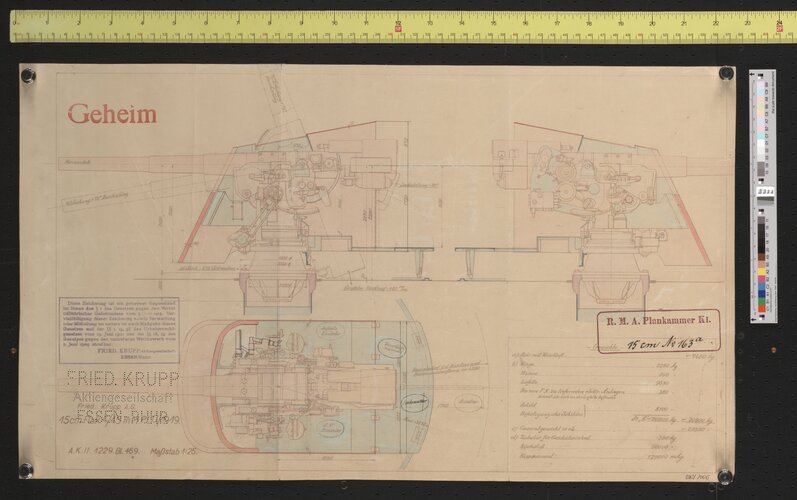
Last edited:
Similar threads
-
Kaiserliche Marine - Imperial German Navy Ship Plans/Discussion
- Started by _Sarcasticat_
- Replies: 104
-
-
Kriegsmarine Naval What-If Ships
- Started by _Sarcasticat_
- Replies: 20
-
I-400 sized German U-boat projects from WW2?
- Started by Vahe Demirjian
- Replies: 10
-
Foreign Dockyards and Naval Bases (Unbuilt/Unrealised)
- Started by Pirate Pete
- Replies: 0

